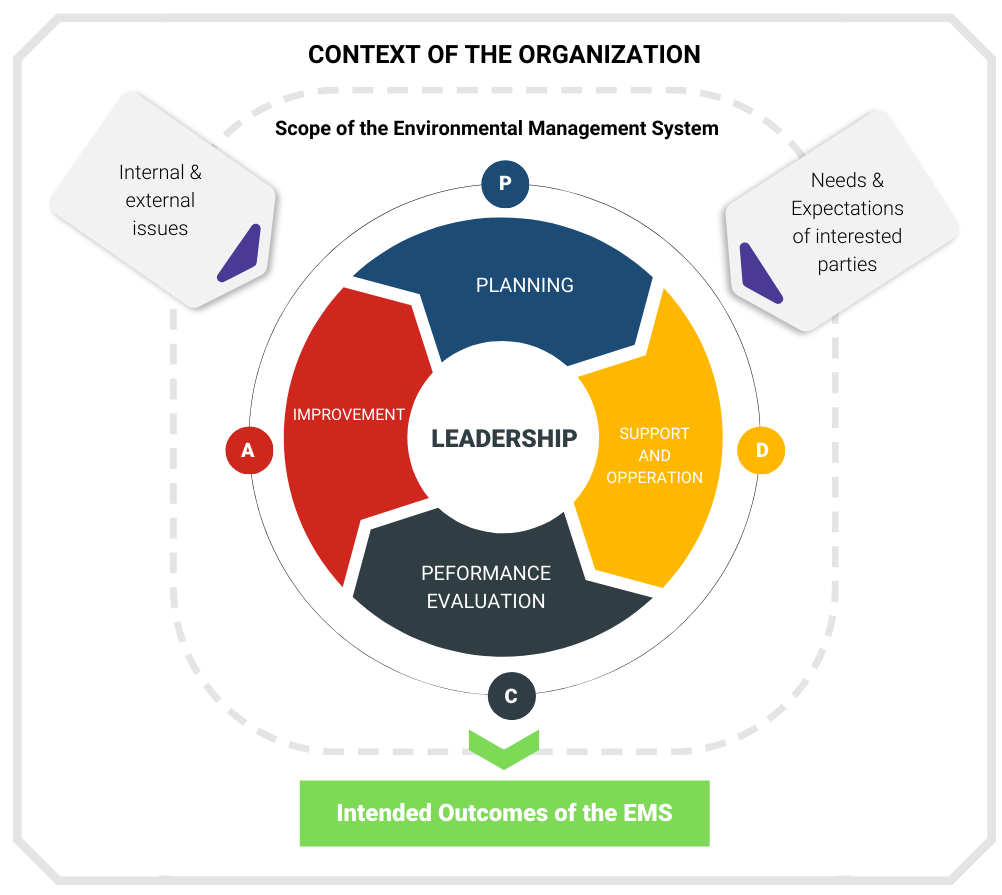Why is this an important question? Its important because there are many stakeholders (ISO 14001 calls them Interested Parties) that care about compliance performance. They care because having compliance issues can be viewed as an indicator of lack of commitment and control. Stakeholders don’t want to be perceived that way by association. This is what ISO 14001 is designed to address. In fact, its central to its Intended Outcomes. Let’s look at how ISO 14001 does this and how it might look for your organization.
ISO 14001: Consistent with the organization’s environmental policy, the intended outcomes of an EMS system include: enhancement of environmental performance; fulfilment of compliance obligations; achieve of environmental objectives.

First, we need a very brief overview of ISO 14001. It is a series of high-level requirements that when fully implemented in an organization through leadership, planning, support, controls, monitoring and improvement, create an environmental management system (EMS) that is designed to achieve the above-mentioned intended outcomes. This blog focusses on the portions of this EMS that enhance compliance performance.
Describe how 14K addresses it
A critical feature of ISO 14001 is that many of its requirements are connected. Its this flow that makes it an effective management system and not just a series of requirements. There are many ways to look at the flows, so be creative yourself in creating some. This a comprehensive one that connects most of the requirements related to compliance performance.

It starts with the Interested Parties. These are other entities that have an interest in what your organization does and expects certain things of it. These expectations may take the form of regulations, if the interested party is a governmental agency, or specific levels of performance if the interested party is the owner or a customer. The expectations that your organization commits or must adhere to become Compliance Obligations. As a result of listening to your Interested Parties, your organization might also identify some Risk or Opportunities that should be addressed. Storage of waste drums outside might be an identified risk. The Compliance Obligations and Risks and Opportunities are acted on through Planning Action. That’s when your organization will decide what resources, training, controls, and monitoring are called for.
The outcome of the monitoring and subsequent analysis and evaluation will be an understanding of your organization’s degree of compliance.
This information might be shared internally with employees or upper management, will be shared through periodic reporting to the relevant environmental agencies and possibly through voluntary reporting such as a sustainability report. Finally, the degree to which this whole process is working will be assessed by a Compliance Evaluation, which usually takes the form of an audit.
Let’s look at a real-world example – one of your major customers is very active in sustainability and has a new supply chain program. They are assessing their suppliers, including your organization, on their EHS performance. This assessment includes questionnaires, audits, and annual reporting. One of the EHS requirements relates to your organization’s compliance. Is ISO 14001 capable of assisting with this challenge? Certainly. This is probably how it would unfold:
- You’ve recognized your major customer as an Interested Party that expects its suppliers to be in compliance.
- You’ve had a history of hazardous waste fines and subpar practices that have never really been resolved. This risk has now escalated because its no longer strictly between you and the agency. Management commitment now exists to support actions to improve the program.
- You create an action plan to refresh the hazardous waste program to ensure proper empty drums are available, labels are available and completed properly, storage locations are well maintained and that the waste does not accumulate prior to being picked up by an approved provider.
- You then roll out these updated controls and make sure everyone is trained, there is ownership and accountability.
- You will monitor the program through inspections, an annual compliance audit, and tracking spreadsheets and report on your performance to management.
- You are confident that when you communicate your new reports to the customer will no longer include NOVs.
Certification of your ISO 14001 environmental management system can assist with implementing, maintaining, and improving your compliance efforts and make them more credible to interested parties. SAI Global’s auditors will conduct annual independent audits of your EMS to verify how well you are following the standard and your procedures and provide opportunities for improvement.

